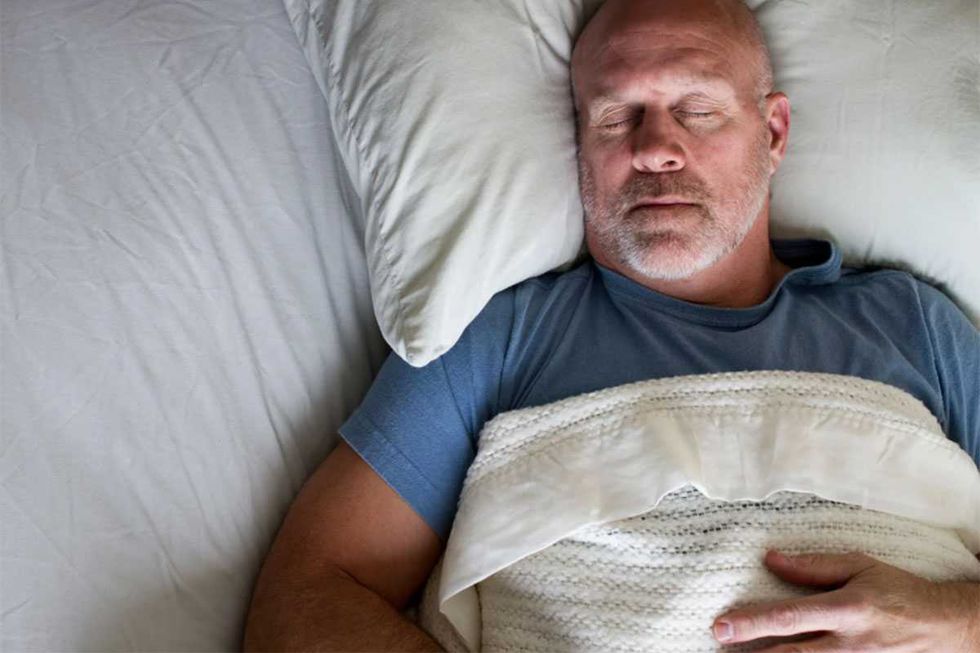College professors share the secret of how to catch ChatGPT in term papers – good.is

Facebook is critical to our success and we could use your help. It will only take a few clicks on your device. But it would mean the world to us.
Here’s the link . Once there, hit the Follow button. Hit the Follow button again and choose Favorites. That’s it!
Writing experts can tell which essays were written by a human versus a robot.
A professor stands in front of the class with a robot
Some current college students welcome our A.I. overlords, especially when it comes to writing up term papers. ChatGPT has become a popular way for many students to cut corners when typing up essays, to the point where some barely write anything at all aside from the prompt. However, a study is showing that ChatGPT and other artificial intelligence programs aren't fooling any college professors and can expose students who are slacking off.
A published international study is showing that college professors can tell which essays are genuinely written by students versus ones that are compiled and cooked up by ChatGPT. The researchers at University of East Anglia and other universities that participated in the study analyzed 145 essays written by British university students and 145 essays written by ChatGPT with both batches writing about the same topics. What they have found is that while A.I. and large language models (L.L.M.s) wrote with proper grammar and were academically coherent, all of those essays lacked engagement techniques that are typically used by humans.
The essays written by human students were easily spotted as the average one contained nearly three times more engagement features compared to the A.I.-generated essays. These engagement techniques include personal asides, rhetorical questions, reader mentions, and persuasive language that is usually used to help back up an essay’s argument or perspective. It makes the essay feel more conversational with the reader compared to facts being “talked at” by ChatGPT. Without additional, specific prompting, A.I. is incapable of making dry subject matters and content compelling to read with a personal touch.
See on Instagram
While A.I. will likely improve over time and the growing concern to use it to outright cheat continues to grow, university officials are more concerned about the students cheating themselves. “When students come to school, college, or university, we’re not just teaching them how to write, we’re teaching them how to think – and that’s something no algorithm can replicate,” said Prof. Ken Hyland, a co-author of the study. The worry is that if students don’t write the essays themselves, they won’t exercise critical thinking skills and abilities that could help them later in their chosen careers and, frankly, life in general.
Model Lauren Chan's 2025 Sports Illustrated Swimsuit issue cover, photographed by Ben Watts
Lauren Chan made history this past April when she became the first out lesbian to cover Sports Illustrated's famed swimsuit issue.
Chan has been a plus-size model for over a decade, and in that time has been a vocal advocate of body diversity and size inclusivity in the fashion world.
On the cover she’s sexy in a green bikini, of course, but in accordance with her longstanding dedication to celebrating bodies of all kinds, Chan also took the time to show some of the angles that didn’t end up on the cover.

“This is what I looked like the day I shot my @si_swimsuit cover—these angles just don’t make it to the pages of the magazine,” she wrote, sharing pictures and video of what her body looked like behind the scenes, unretouched, below. She felt it was important to share. “You need to see them and I’d like for you to read this: I’m in my thirties, my tits have fallen, no workout ever toned my mid-section, my skin is loosening, any ass I had is looong gone…and I feel better than ever.”
See on Instagram
Chan shares that her journey to body acceptance was a long one, as it is for many people, and many women in particular. “That’s not because I’ve gotten any smaller, it’s thanks to the shift in my mental health that has come from living as my authentic self,” she continued. She attributes this in part to coming out and coming into her queerness, which she did publicly with a Vogue essay in time her first Sports Illustrated Swim appearance in 2023. That authenticity, she says, also has a lot to do with understanding that sexiness isn’t a pose, but rather, as she writes below, “about being present; it’s about being at peace with who you are. And it’s about letting people f^#! off if they don’t like it.”
See on Instagram
Chan had been in the fashion world not just as a model, but as a writer and editor–she previously worked at Glamour. It was there that she began covering size inclusivity. “It was a topic that data proved would work, yet, at the time, there wasn’t anyone currently at the magazine to be the face of that,” she told Elle in 2023. Chan became the face, and soon was all over television and the fashion world. She later left to start a size inclusive clothing brand, Henning, that was later purchased by the brand Universal Standard, and to continue modeling. The first time she appeared in Sports Illustrated’s swimsuit issue, she was the first queer, plus-size Rookie model in the magazine, Elle shared. Charting a path is just what she does.
Now, with the success of the Sports Illustrated cover, Chan continues to bring her message with her. “Bigger bodies are artful, too,” she said on a recent Sports Illustrated body image panel. “What I really tried to do is stop posing in a way that was minimizing my insecurities. Rolls can be the art. It can be the reference you're trying to achieve. And then when it's printed somewhere like this, hopefully that becomes the reference for other people.”
This article originally appeared earlier this year.
The Bee Gees paid tribute to The Beatles in 1973, playing a five-song acoustic medley on late-night TV.
The Bee Gees are rightly remembered, first and foremost, for dominating the disco era. Their work on the Saturday Night Fever soundtrack is unimpeachable, from the sidewalk-strutting "Stayin’ Alive" to the tender balladry of "How Deep Is Your Love." But for fans unfamiliar with their earlier work, it’s often shocking to learn about the brother-trio’s other musical phases, including psychedelic-pop and folky soft-rock.
One excellent showcase of that range dates back to August 10, 1973, when they played a stripped-down acoustic medley of five Beatles classics on late-night show The Midnight Special. It was an interesting (and perhaps savvy) promotional choice: The band’s 11th and most recent LP, that year’s Life in a Tin Can, earned middling reviews and below-average sales, only reaching No. 69 on the Billboard 200. Perhaps looking back to The Fab Four—who’d broken up in 1970—was a safer bet than their single "Saw a New Morning," which petered out at No. 94 on the Hot 100.
Reasoning aside, the performance is stunning, highlighting the Bee Gees’ tight vocal harmonies and clever arrangements that flow gracefully between major and minor keys. Only utilizing their voices and a pair of gently strummed acoustic guitars, the group (Barry, Robin, and Maurice Gibb) work through some of their favorites from the early Beatles catalog: "If I Fell," "I Need You," "I’ll Be Back," "This Boy," and "She Loves You," earning the biggest applause for the latter staple.
The Bee Gees, The Beatles, 1973, The Midnight Special, medley, cover, acoustic, Barry Gibb, Robin Gibb, Paul McCartney YouTube
This was a unique time in the band’s career, predating Saturday Night Fever’s commercial explosion by four years. But The Beatles' influence played a major factor in what happened after that blockbuster album—and not in an ideal way: In 1978, The Bee Gees starred in a musical based on that band’s 1967 masterpiece, Sgt. Pepper’s Lonely Hearts Club Band, and the film was a major box-office bomb (However, the soundtrack—which featured the Bee Gees covering a handful of Beatles songs—fared much better, peaking at No. 5 on the Billboard 200).
The Bee Gees, The Beatles, 1973, The Midnight Special, medley, cover, acoustic, Barry Gibb, Robin Gibb, Paul McCartney YouTube
The two bands were friendly over the years—for proof, just consult this Reddit thread rounding up photos of their various members together. Robin Gibb even talked about nerding out about Beatles songs backstage with Paul McCartney one year at the Grammys. "He invited me to the dressing room 'cause we’d met, and once again you just find yourself wanting to talk about songs," he told interviewer Tim Roxborogh. "I just kept saying, 'If I Fell,' 'If I Fell,' Paul!' [Laughs.]…He’s very kind and very gentle and respectful."
The Bee Gees, The Beatles, 1973, The Midnight Special, medley, cover, acoustic, Barry Gibb, Robin Gibb, Paul McCartney YouTube
In that same interview, Gibb mentioned that McCartney even recorded a Bee Gees cover—though, as of this writing, it appears to remain unreleased. "He recorded [1978’s] ’Too Much Heaven,'" he said. "It never went out, but he wants to send me the master so I can look at it and see if we can really enhance it, but Robin got him to do 'Too Much Heaven' in England…He’s always been one of my heroes, and just knowing the man is inspiring." McCartney seems to feel the same way: When Gibb received a Kennedy Center Honor in 2023, the Beatle appeared in a video promo, enthusing, "Barry Gibb is one of the greats!"
This article originally appeared earlier this year.
More and more older couples are sleeping in different rooms.
For many people, having a partner in bed with you is a great way to end your day and go to sleep. Aside from the physical activity, it can be nice to share a warm bed and snuggle up with a person you love to release feel-good chemicals through cuddling, have a second body to help warm up the bed, and feel connected with your partner.
However, many older couples are routinely sleeping independently without any issue. Why is that? Well, many younger folks have gone to Reddit to ask older people why they’ve decided to stay together yet sleep alone with their spouses or partners.

For most of the older couples, the move to sleeping in separate quarters was for practicality:
“I was absolutely sick of being asked in the middle of the night to sleep on the sofa due to snoring. A few years back we got a puppy and I moved downstairs to sleep to facilitate the 4 times a night it needed to go out. The move became permanent. It just works better.”
“My husband hated it at first, too, when it was just occasional nights that I would sleep in another bedroom or on the sofa, but when he started having trouble sleeping, too, and started realizing how much better he slept when I wasn't tossing and turning next to him, he got on board.”
“I’m a morning person in need of a quiet space to sleep while my husband is a night owl and needs to fall asleep to the TV.”
“My habit is to read for an hour or 2 before dozing off. Husband needs TV on. I sleep cold, he sleeps hot. The last time we shared a bed, he kicked me out and I hit my head on the nightstand. Separate rooms.”
“We are both terrible sleepers as we get older and we end up waking each other up all night with tossing and turning, trips to the bathroom, snoring, etc. At some point, a good night of sleep becomes more important than sleeping in the same bed.”
While one can think that this is a red flag indicating a problem in the relationship. After all, the telltale sign of trouble in a relationship on TV and in film is when one half of the couple sleeps on the couch. But many of these posters say that this isn’t the case:
“We also spend time in bed together every night before retiring to our separate rooms, and I think that's an important habit to maintain. It's OK not to do it every night, but for us, anyway, it maintains the emotional and physical intimacy, and I notice a difference if we skip that time together for more than a week.”
“I sleep from 9pm – 5am and he sleeps from 12am – 8am. Our relationship is healthier, and people act like it means we aren’t intimate anymore lol. As if intimacy is only at night in the bed.”
“I usually climb into bed anywhere from 0-4 hours before she gets up, and we always cuddle. But we almost never go to sleep at the same time. That's why I tuck her in every night. We cuddle a lot before she goes to sleep, and joke around and she teases me or I tease her until she wants to go to sleep. :)”
“We spend time in bed together every night before we go to sleep, and then we retire to our separate bedrooms and get a good sleep.”
A 2017 poll from the National Sleep Foundation found that one in four couples actually sleep separately. So is this “sleep divorce” practice actually healthy? Or will it just lead to actual divorce? Well, according to psychologist Dr. Joseph Cilona of Manhattan, it all depends on the reasoning behind getting separate bedrooms.

"The effects of sleeping in separate rooms can be extremely positive for a relationship, extremely negative for a relationship, or anything in between," said Dr. Cilona to USA Today. “Each couple should examine and discuss clearly and specifically their thoughts, feelings, and needs around this issue to find a mutually satisfying compromise."
In short, it appears that whether it’s healthy if you sleep together or separately depends on “why” you’re not sleeping together. Many of these psychologists believe that as long as both partners are on board and that the purpose is so that your loved one can get quality rest that it shouldn’t negatively impact the relationship. In fact, both people in the couple getting quality sleep ultimately makes each one happier overall.
Whether alone or together, having a good night’s rest leads to better connection and life with your partner.
(L) Jack White speaks into a microphone; (R) a ripped couch
Few rock stars know how to build mystique like Jack White—from playing super obscure vintage guitars to color-coding his various musical projects. The coolest example dates back to 2004, when he recorded a single, pressed 100 vinyl copies, and hid them all inside random pieces of furniture.
Before we dive in, let’s tackle some backstory. Prior to his music career, White worked as a professional upholsterer in his native Detroit—first as a teenage apprentice, assisting friend and future bandmate Brian Muldoon. White opened his own shop, Third Man Upholstery, at age 21 and made enough money to pay the bills. But he also turned that business into a kind of art project, likely alienating potential repeat customers with his unique style.
"I was so strange with it," he recalled during an interview on Conan O’Brien Needs a Friend. "I was doing sculpture as well. Everything became an art form with me—I was filling the inside of the furniture with poetry, and the bills I was writing in crayon. It would be yellow paper with black crayon: 'You owe me $300.' I would present it to them, and I’d deliver the piece in a yellow-and-black uniform in a yellow van that was an old Detroit fire-department van. People were like…"What?’"
Jack White, The Upholsterers, The White Stripes, vinyl, hidden vinyl, Third Man Records, rock history, art, treasure hunt, Detroit music YouTube
Speaking to NPR in 2011, White said that he and Muldoon even started passing along notes to fellow upholsterers inside the pieces. "We’re the only ones who see the insides of this furniture," he said. "'We should have so many inside jokes and things we could write.’ You know, 'This guy was a jerk. He wouldn't pay for this.' We should be telling each other what was the story on these couches."
He and Muldoon formed the fittingly named garage-punk duo The Upholsterers in 2000 and released one official single, "Makers of High Grade Suites," that year (it’s since become a major collector’s item: As of this writing, record-resale site Discogs lists a price range of $250 to $1,500, with a median of $1,066.65). But that wasn’t the band's only recording: The Upholsterers reportedly celebrated the 25th anniversary of Muldoon’s shop by recording those 100 copies of a second single and stuffing the vinyl into furniture.
Jack White, The Upholsterers, The White Stripes, vinyl, hidden vinyl, Third Man Records, rock history, art, treasure hunt, Detroit music YouTube
"We even made it on clear vinyl with transparency covers—we thought you couldn't even X-ray it to see if it was in there," he told NPR. "I’m talking about—really, you could rip open a couch and think it's not there 'cause it's inside the foam—sliced inside the foam and slid in there. I mean, we really went to great lengths to make sure possibly no one would ever hear our record! But it's there. It's so great. It's there. There's [100] pieces of furniture out there that have those records, and maybe one day someone will find them."
According to White’s Third Man Records label, that miracle long-shot came true in 2014, when two people claimed they’d found separate copies of Your Furniture Was Always Dead … I Was Just Afraid To Tell You.
After White’s music career took off via The White Stripes—followed by his solo work, along with The Raconteurs and The Dead Weather—he wasn’t able to focus as much on upholstery. But he’s never quit that pursuit. "While White may have stopped doing upholstery as a 'job' he’s never stopped his actual practice of the trade," reads a note on the Jack White Art and Design site. "In the intervening 20+ years Jack has always kept an operational upholstery shop in his house or on his property. Third Man Upholstery is now located in Nashville, TN."
Jack White, The Upholsterers, The White Stripes, vinyl, hidden vinyl, Third Man Records, rock history, art, treasure hunt, Detroit music YouTube
That skill has been a big part of his life in recent years, including in the early pandemic year of 2020, when, as he told O’Brien, he "worked on nothing but furniture, really." As he explained on the podcast, he even offered to redo the comedian’s furniture back when he launched Conan in 2010.
"I don’t have a lot of regrets in life," O’Brien said, "[but] one is: When we were doing our show at TBS, you contacted me, and I had no idea you were serious. You said, 'I’d like to do the upholstery. I’d like to make you your talk-show couch.' I was like, 'That’s so hilarious, man. That’s great.’ Later on, you were like, 'No, no, I was serious!'…I felt like it was such a lost opportunity to have a talk show where Jack White made my talk-show couch."
This article originally appeared earlier this year.
How long should you stay in your shower?
Some doctors now believe you should be spending even LESS time in the shower than previously thought. Admittedly, I was already shocked when I found out a while back that the average shower should take only eight minutes. But upon reflection, it made sense. While hot showers can feel relaxing, we obviously need to be conscious of our resources, no matter where we live in the world.
But a recent piece by Pang-Chieh Ho called "You Could Be Showering Too Long," published in Consumer Reports, claims that showers should really only be around five minutes, seven at the most. Just shaving off a couple of minutes can help tremendously with conservation. "For people in the U.S., the average shower lasts about 8 minutes, according to the Environmental Protection Agency. That’s 20 gallons for every average shower, given that the standard showerhead uses around 2.5 gallons of water per minute."

And it's not just because of the environment. Our skin can dry out more quickly than some might think. Dermatologist Lisa Akintilo, MD, is cited as saying, "It’s true that long, hot showers may feel restorative, but they can dry and irritate the skin."
An article in Time magazine, "How Much Do You Actually Need to Shower?" by Angela Haupt, reveals that some doctors say you can skip even the five-minute daily shower, though they admit, "there's no one-size-fits-all equation." Dermatologist at NYU Langone Health, Dr. Mary Stevenson, suggested, "Ideally, I think people should shower at least every other day. Most people, by day two or day three, are not clean. But it’s a little bit personal." She later added, "In general, you really only need soap in your armpits, your groin, and your feet."
Some people on Reddit disagree. In a thread called "On average, how long do you take to shower?" many admitted that long showers are a guilty pleasure. A few people answered 45 minutes to an hour. One even claimed they showered for "light years," though someone quickly pointed out that "light year" was a measurement of distance, not time.
One noted that there are variables in play. "Depends on how many shower beers."
Another measures the length of time in music. "Two Spotify songs," they insisted.

One Reddit user got vulnerable about the mental benefits of a hot shower. "The mean and the median probably differ quite a lot for me. The vast majority of my showers do not exceed 20 minutes, but I've had some depression showers or anxiety showers or whatever you wanna call them where I stayed in for over an hour." Another commenter put it less delicately: "Until I can no longer feel the pain of life."
And lastly, this person didn't mince words but mentioned the temperature variable. "If it's a hot shower, no less than 30 minutes. If it's a cold shower, I scrubba dubba the F out of there in less than three."
This article originally appeared earlier this year.
(L) Derek Shulman; (R) Elton John
In the late '60s, before Elton John officially became Elton John, immortal pop-rock superstar and one of music’s best-selling artists, he was simply Reginald Dwight: a young songwriter searching for his musical identity. During that pre-fame era, he was briefly bandmates with Derek Shulman in the psychedelic soul group Simon Dupree and the Big Sound. And while they lost touch over the years, the pair reconnected decades later through a kind gesture: Shulman gifting John a demo recording of a song the latter forgot he’d ever written.
That friendship formed when then-Dwight filled in as a touring member of Simon Dupree. "Elton was Reg at the time, and the keyboard player in my first group was sick," Shulman told this writer in an interview for Ultimate Classic Rock. "He was recruited by our manager, and he loved playing with us. He's a real muso. We went to his house, and this was around the time when [lyricist Bernie Taupin] came down from Lincoln. This was literally the start of his Elton John period and career."
Shulman and his bandmate/brother Ray were impressed with their talented fill-in keyboardist, even recording a version of his song "I’m Going Home." They also became close with Dwight/John, quietly telling him their idea to dissolve Simon Dupree and start a more progressive, adventurous new band. (They later did just that, forming one of prog’s most revered and experimental acts, Gentle Giant, in 1970.) The combination seemed perfect on paper, but their songwriting didn’t seem aligned.

"He loved that thought. He said, 'I’d love to discuss with you what you want to do. I've written some songs,'" Shulman said. "He played [future Elton John tracks] 'Your Song' and 'Skyline Pigeon.' And that was right when Bernie arrived in the living room of his house. We didn't say it, but we thought, 'This isn't really where we want to go,' and thank God for him! He said, 'I’m changing my name to Elton John,' and we said, 'Well, that won't work.' Of course, the year after, he became Elton John and became massive, and good for him. But we were there when he was doing his first album."
Elton John, Derek Shulman, Gentle Giant, Simon Dupree and the Big Sound, 60s music, rock history, music history, lost songs, demos, Bernie Taupin YouTube
They remained friendly, despite their collaboration not moving forward. "Lucky for him," Shulman added. "He was at the Troubadour becoming massive, and we were scrambling for gigs." After losing touch over a couple decades, Shulman eventually reached out, and they had a "fantastic" time catching up, gift included. "We recorded a couple songs in my first group that Elton wrote, and I had the demo in my closet of Elton singing the song 'I’m Going Home,'" he said. "[John had] forgotten about it. I gave it to him, and he didn't have it in his library…It was great to give him back a song that he'd forgotten he'd written."
Elton John, Derek Shulman, Gentle Giant, Simon Dupree and the Big Sound, 60s music, rock history, music history, lost songs, demos, Bernie Taupin YouTube
"It was very funny that he'd forgotten he'd written that," he added of "I'm Going Home," which was included on the 2004 Simon Dupree compilation Part of My Past. The "piano demo" version was released on the deluxe edition of 1970's Elton John, the songwriter's second LP. (Shulman added that John "also played on a couple other [Simon Dupree] tracks that never came out as singles.")
Elton John, Derek Shulman, Gentle Giant, Simon Dupree and the Big Sound, 60s music, rock history, music history, lost songs, demos, Bernie Taupin YouTube
Though it would have been incredible to hear Elton John playing with Gentle Giant, a genre-blurring band that combined elements of hard rock, chamber music, funk, and medieval music, their divergence probably worked out best for everyone. It’s interesting, though, that John also had another "what if" prog-rock moment: nearly connecting with King Crimson for their second LP, during a time when they didn’t have a permanent singer. In the liner notes of their 1976 compilation A Young Person's Guide to King Crimson, bandleader Robert Fripp wrote, "Elton had been booked to sing all the songs on [In the Wake of Poseidon] for £250 as a session singer and as I wasn't familiar with his work, Mark Fenwick of E.G. [Records] gave me a copy of Elton's first album. But his style didn't seem right for Crimson, and the album was poor, so I canceled the sessions."
Again, after selling over 300 million albums throughout his career, it’s hard to imagine he has any regrets.
This article originally appeared earlier this year.
Left: Phil Collins; Right: Rick Allen
Rick Allen has one of rock music’s most inspirational stories: The Def Leppard drummer tragically lost his left arm following a 1984 car accident, but he relearned to play on a custom drum kit, while the band went on to reach their biggest commercial success. That redemption may have never happened, though, without the uplifting messages he received, including one from another famous drummer: Phil Collins.
Allen was, naturally, in a dark place following the accident, which happened Dec. 31, 1984, in the Sheffield, England area, when he was only 21. The prior year, Def Leppard had released their blockbuster LP Pyromania—which featured the hit singles "Photograph," "Foolin’," and "Rock of Ages"—and now the future looked uncertain. But hearing from Collins, an immensely popular singer-songwriter and one of the world’s most revered drummers, gave him a crucial confidence boost.
As Ultimate Classic Rock notes, Allen opened up about their exchange in a 2021 interview with Mitch Lafon, saying Collins’ letter "happened to be one of the first" that he opened while he was "actually still in hospital in 1985." It amounted to "incredible words of encouragement."
Def Leppard, Rick Allen, Phil Collins, 80s rock, drummer, Hysteria, rock and roll history, comeback story, inspiration, music history YouTube
"[T]here were hundreds of thousands of letters, but his stood out because he obviously knew what it would be like—or he had an inkling of what it would be like—to be a drummer and to be involved in something so horrific," he said. "So it just meant that much more.”
As Allen mentioned, plenty of regular folks also sent encouraging letters—and they also helped him in the recovery process, inspiring him to find another, more unconventional approach to his instrument. As Blabbermouth reports, he told Modern Drummer, "I remember coming around in the hospital and then realizing what had happened to me after the accident, and honestly, I wanted to disappear. I didn't wanna do this anymore. And then I started getting these letters from all over the world."
"I don't know what happened," he added, "but I discovered the power of the human spirit and just said, 'You know what? I can do this.’ It was really a collective thing. It was all this encouragement I was getting from other people, and then it just manifested in wanting to succeed. And that's exactly where it came from."
Def Leppard, Rick Allen, Phil Collins, 80s rock, drummer, Hysteria, rock and roll history, comeback story, inspiration, music history YouTube
Allen’s return to music is a feat of ingenuity, dedication, and friendship. Backed by supportive bandmates, he stayed in Def Leppard by learning to navigate a custom kit that triggers various drum sounds—the ones he used to play with his left arm—via his left foot. He returned to live performances on Aug. 16, 1986, at the British festival Monsters of Rock, and played on their biggest-selling album to date, 1987’s Hysteria, which features a series of massive singles, including "Pour Some Sugar on Me," "Love Bites," and "Armageddon It." As of this writing, he’s still in the lineup.
In a 2021 interview with ABC News, Allen was asked, if able, whether he’d go back in time and prevent his accident. "That’s a really good question," he said. "I think it enabled me to grow in so many ways. It became a blessing, a responsibility—a responsibility to other people, to myself. And I think that has become a huge gift."
Def Leppard, Rick Allen, Phil Collins, 80s rock, drummer, Hysteria, rock and roll history, comeback story, inspiration, music history YouTube
This article originally appeared earlier this year.
Jordan speaking at a ribbon cutting ceremony for one of the earlier Novant Health clinics in 2019.
After successfully building three other clinics, as mentioned on Upworthy and Scoop Upworthy, NBA all-star Michael Jordan teamed up once again with Novant Health to build a fourth clinic for the uninsured in North Carolina. The health clinic is the second one built in Wilmington and opened on February 19, 2025.
Jordan is considered by many to be the greatest basketball player to compete in the National Basketball Association. With a career at the top spanning from 1984 through 2003, Jordan became a six-time NBA champion and four-time gold medalist in the Olympics. Jordan would be inducted in the NBA Hall of Fame in 2009.
– YouTubeyoutu.be
This creation of this health clinic was based on the benefits shown from the previous clinics in the state. After the success of the first clinic, Jordan gifted $10 million to Novant Health to expand and create others. Each location was chosen based on the barriers the community was facing in obtaining health care, including transportation. Many patients had their first primary care visit with a physician thanks to Jordan’s clinics providing these services for people who cannot afford health insurance.
This new clinic will have a standard primary care team of physicians, but also a community health worker to assist the patients and grant access to community resources. The 7,3000-square-foot clinic and its 12 patient rooms will be open on weekdays.
Unfortunately, many people still lack access to affordable health care and health insurance. According to the U.S. Department of Health and Human Services, 27.1 million Americans were uninsured in the first quarter of 2024. Keep in mind that being insured doesn’t necessarily mean that a person’s health needs were met or had received full coverage. A 2024 YouGov poll showed that 49% of Americans were dissatisfied with the state of the U.S. health care system.

So what can a person do to improve their health care? Individually, if a person obtains health insurance through their employer, they can investigate speaking to their HR representative or union head and work with them to go through different plans for you and your coworkers to find the best option. Discuss gaps in various coverage and see if your employer is open to finding a different employee health plan to address those gaps. If you don’t have a health care plan through your work, you can see what options are available to you through the Affordable Care Act.
If you aren’t finding the health care you are looking for and want to enact larger change, you may want to get politically involved. Investigate to see if there are groups in your area advocating for the change you want to see in the American health care system. They can point you towards proposals, elections, and candidates that fit your views and that you can help get elected or enacted.
Doing so will help not only yourself, but help others gain access to the health care you wish to receive, much like Michael Jordan’s generous gesture. It's a slam dunk for the whole team.